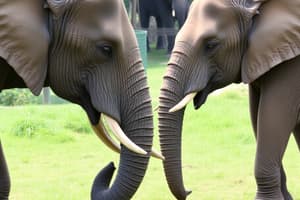Podcast
Questions and Answers
What is the main focus of the text?
What is the main focus of the text?
- The physical characteristics of elephants
- The use of sensor technologies to prevent train-elephant collisions (correct)
- The history of railways
- The economic impact of train-elephant collisions
Why have incidents of train-elephant collisions escalated according to the text?
Why have incidents of train-elephant collisions escalated according to the text?
- Increased human population near railways
- Expansion of railways through elephant habitats (correct)
- Elephants seeking shelter near train tracks
- Elephants being attracted to trains
What is the proposed solution in the text for preventing train-elephant collisions?
What is the proposed solution in the text for preventing train-elephant collisions?
- Building taller train compartments
- Creating artificial barriers around tracks
- Integrating sensor technologies for real-time detection (correct)
- Using drones to scare away elephants
How do sensors contribute to preventing elephant-train collisions?
How do sensors contribute to preventing elephant-train collisions?
What is the intended outcome of developing a warning system with sensors and thermal cameras?
What is the intended outcome of developing a warning system with sensors and thermal cameras?
Based on the text, what role do sensor technologies play in addressing elephant-train collisions?
Based on the text, what role do sensor technologies play in addressing elephant-train collisions?
What is the primary goal of the efforts to address the problem of train accidents involving elephants in Sri Lanka?
What is the primary goal of the efforts to address the problem of train accidents involving elephants in Sri Lanka?
Which of the following is identified as a root cause of the problem of train-elephant collisions in Sri Lanka?
Which of the following is identified as a root cause of the problem of train-elephant collisions in Sri Lanka?
What is the main challenge in creating an effective system to prevent collisions between trains and elephants in Sri Lanka?
What is the main challenge in creating an effective system to prevent collisions between trains and elephants in Sri Lanka?
What is the relationship between the presence of vegetation near railway tracks and the occurrence of train-elephant collisions in Sri Lanka?
What is the relationship between the presence of vegetation near railway tracks and the occurrence of train-elephant collisions in Sri Lanka?
Which of the following measures is identified in the text as a potential solution to reduce train-elephant collisions in Sri Lanka?
Which of the following measures is identified in the text as a potential solution to reduce train-elephant collisions in Sri Lanka?
How does the timing of train-elephant collisions in Sri Lanka contribute to the problem?
How does the timing of train-elephant collisions in Sri Lanka contribute to the problem?
Flashcards are hidden until you start studying
Study Notes
- Efforts are being made to address the issue of train accidents involving elephants in Sri Lanka to minimize harm to both elephants and humans.
- The ideal situation is to implement advanced warning systems, barriers, and wildlife corridors to prevent collisions between trains and elephants.
- The main problem identified is the need for a reliable multi-sensor system to prevent collisions between trains and wildlife, particularly elephants, in diverse terrains.
- Root causes of the issue include habitat fragmentation, food sources near tracks attracting elephants, nocturnal activity leading to collisions, and high train speeds reducing reaction time.
- The integration of sensor technologies, such as thermal cameras, is proposed as a solution to detect elephants on railway tracks and prevent collisions effectively.
Studying That Suits You
Use AI to generate personalized quizzes and flashcards to suit your learning preferences.





